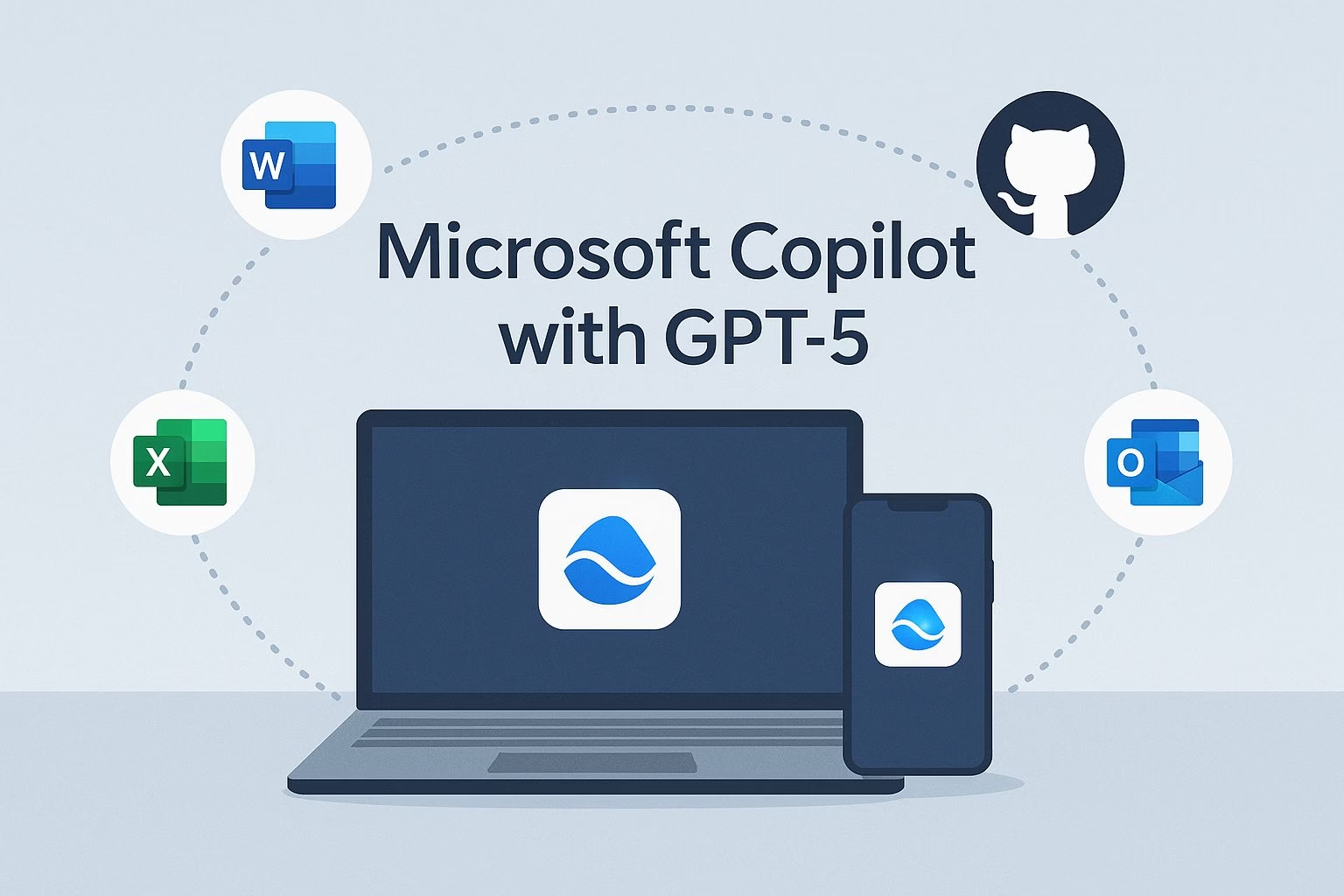Microsoft Copilot Rolls Out GPT-5 Across All Platforms
Microsoft has officially rolled out GPT-5 across its entire Copilot ecosystem, marking one of the biggest updates to its AI services in years.
The upgrade applies to Microsoft 365, the standalone Copilot app, GitHub Copilot, and Azure AI Foundry, and it’s available to everyone, not just enterprise users.
You can read the announcement here: Microsoft News.
What makes this shift stand out is how deeply GPT-5 integrates with workflows.
Instead of being a tool you query and wait on, Copilot can now adapt to your context, whether you’re drafting an email, working through a spreadsheet, or coding in GitHub.
It doesn’t just answer questions. It detects tone, interprets intent, and cross-references content across apps to respond in a more natural and human-like way.
This positions Copilot differently from ChatGPT. Where ChatGPT feels like a standalone assistant, Copilot with GPT-5 is being built into the flow of work.
That move signals Microsoft’s aim to turn AI from a helpful add-on into a constant collaborator, ready on Windows, Mac, web, or mobile without barriers.
What’s new inside Copilot with GPT-5
The most immediate change users will notice is the new Smart mode. Instead of making you pick between quick suggestions and deeper analysis, Copilot now switches automatically depending on the task at hand.
Writing a short reply? You’ll get a concise draft.
Working on a larger document? Copilot shifts to detailed reasoning without you needing to adjust settings.
Another big shift is the expanded context window. GPT-5 can track not just the current prompt but also email chains, document history, and even the overall task you’re trying to accomplish.
This gives it a clearer understanding of intent. For example, if you’re preparing a report, it can pull in past notes, highlight related emails, and suggest structure based on previous drafts.
Copilot is also becoming more sensitive to tone and meaning. It can spot subtle changes in language, detect when you’re trying to be formal or casual, and adjust output accordingly.
This kind of awareness is what makes its responses feel closer to a real colleague than a scripted assistant.
Why the GPT-5 rollout matters
Unlike earlier versions, GPT-5 is not locked behind enterprise or premium tiers. Every Copilot user, including non-subscribers, now has access to the same advanced model.
This levels the field and makes powerful AI available to anyone on Windows, Mac, mobile, or the web.
That availability is key because it shows Microsoft positioning Copilot as a platform-wide layer of intelligence, not just an extra feature for paying customers.
It makes Copilot competitive against standalone AI apps like ChatGPT by embedding intelligence directly where people work. Instead of shifting between tools, users can rely on Copilot as part of their natural workflow.
The move also highlights how Microsoft wants AI to evolve from being reactive to being proactive. Copilot doesn’t just wait for commands anymore.
With GPT-5, it interprets what you’re working on, looks at the bigger picture, and takes initiative by surfacing suggestions that fit the task. That shift could change how people interact with their daily software.
How this compares to earlier Copilot versions
Previous Copilot releases felt more like optional add-ons. They could generate drafts, summarize documents, or suggest code, but the experience often required extra clicks or manual setup.
With GPT-5, those steps are reduced because the model adapts in real time to whatever you’re doing.
Earlier versions also had smaller context windows, which limited how much background Copilot could use when crafting responses.
That often meant answers felt generic or disconnected from ongoing work. GPT-5 expands that capacity so it can keep track of multiple layers of context, from related emails to past project notes.
The difference is especially clear in longer workflows where continuity matters.
Another key improvement is how GPT-5 handles nuance. Past iterations could misread tone or produce overly formal replies in casual settings.
Now Copilot can align with the style you need, whether professional for business communication or relaxed for a team chat.
That level of control without manual editing sets it apart from what came before.
What this means for rivals in the AI space
Microsoft’s decision to make GPT-5 broadly available through Copilot changes the competitive field.
Tools like ChatGPT remain strong for direct queries and standalone use, but Copilot’s strength is in being built into existing apps.
For people who spend their days in Outlook, Word, Excel, or GitHub, the convenience is hard to ignore.
This move also raises pressure on rivals like Google, which is pushing Gemini into Workspace. Both companies are racing to define what an AI-first productivity suite looks like.
By lowering barriers to entry, Microsoft ensures that users don’t need to think twice about trying Copilot, while Google’s tiered approach could feel more restrictive in comparison.
There’s also a broader implication for AI adoption. By blending GPT-5 into everyday tools, Microsoft is normalizing the presence of AI in daily workflows.
People who might not seek out a standalone chatbot are now interacting with advanced AI as part of their routine. That widespread exposure could shift user expectations across the industry.
How users will benefit day to day
For most people, the impact of GPT-5 inside Copilot will be felt in small but frequent ways.
Writing emails becomes faster because the model understands past conversations and can draft replies that match your usual tone.
Working on documents or spreadsheets takes less effort because Copilot can recall related material and suggest content without needing manual prompts.
Developers using GitHub Copilot gain an even stronger coding partner. GPT-5’s broader context means it can follow entire projects instead of just a single function or file.
That makes it more reliable when suggesting fixes or generating code that fits into a larger system.
Even for casual users, the shift is noticeable. Someone preparing a school report or a personal budget will see smarter, more connected suggestions.
Since GPT-5 is available to non-subscribers as well, the barrier to trying these features is low, which could accelerate adoption across different groups of users.
Where Copilot could go next
The current rollout sets the stage for deeper integrations.
With GPT-5 already handling broader context, the next step could be tighter connections between Copilot and external apps or data sources.
That would expand its ability to act as a bridge between different tools, not just Microsoft’s ecosystem.
Another direction is greater personalization. Copilot may start tailoring its behavior to each user’s patterns, learning how individuals prefer to work and offering support before it’s requested.
This would push it further into the role of a digital colleague rather than just an assistant.
Finally, Microsoft’s move signals that Copilot is becoming a long-term centerpiece of its strategy.
By tying advanced AI to everyday products and giving wide access, the company is betting that users will come to expect AI as a standard part of their software experience.
That expectation could shape not just Microsoft’s roadmap but also how the rest of the industry adapts.

